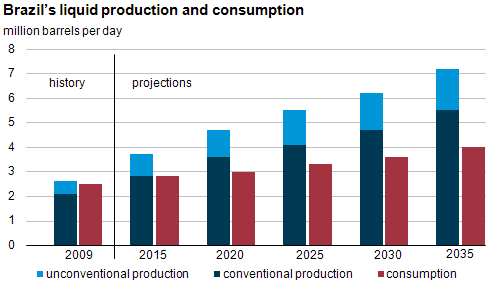
Growth in liquids production puts Brazil on world energy stage

Download CSV Data
Recent growth in oil and ethanol production, coupled with major offshore oil discoveries, could transform Brazil into a pivotal player in world energy markets. In 2009, liquids production exceeded consumption, and EIA's International Energy Outlook projects this export capability will grow as production of both conventional and unconventional liquid products increases, ultimately ranking Brazil fourth in the world for total liquids production in 2035.
Technological advances in recent years have led to offshore discoveries of "pre-salt" oil and natural gas in Brazil. These pre-salt discoveries, found under thick layers of salt thousands of feet below the ocean's surface, are among the biggest finds in recent history. In December 2010, Brazil's state-controlled oil company, Petrobras, submitted a declaration of commerciality for the Tupi and Iracema fields totaling 8.3 billon barrels of oil equivalent (boe). The 6.5 billion boe Tupi field, which has since been renamed Lula, is the biggest oil find in the Western hemisphere since Mexico's Cantarell discovery in 1976.
Pilot projects producing pre-salt oil are underway, and Brazil aspires to double its oil production within a decade. While these resources appear to be enormous, some hurdles could slow the projected growth in production. Pre-salt oil presents numerous technological and infrastructure challenges. Pre-salt drilling requires much higher pressure than typical offshore oil and the salt layer may shift after drilling. The ambitious expansion may require dozens more of the multi-billion dollar floating platforms as well as hundreds of support vessels to reach the platforms, which are out of helicopter range.
EIA's recently released Country Analysis Brief for Brazil details energy production, consumption, infrastructure, energy sector organization, and policy for the ninth largest energy consumer in the world. Brazil's energy sector is uncommon in that the country is a major producer of both conventional and renewable fuels. In 2009, Brazil produced 2.1 million barrels per day of crude oil and 450,000 barrels per day of ethanol, making it the world's second largest ethanol producer (behind the United States). Government policies such as high blending standards and support for flex-fuel vehicles should facilitate increasing levels of ethanol consumption in the future.
Tags: biofuels, Brazil, crude oil, ethanol, international, liquid fuels, offshore, oil/petroleum, policy, renewables